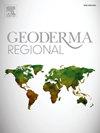Changes in land use and buffaloes trampling effects on soil health in environmentally vulnerable areas of an Atlantic Forest biome in southern São Paulo State, Brazil
IF 3.3
2区 农林科学
Q2 SOIL SCIENCE
引用次数: 0
Abstract
This study was conducted to determine the impact of land use and livestock farming on riparian areas in the state of São Paulo, Brazil. A range of physical, hydraulic and chemical properties were measured in hydromorphic soils under four scenarios; namely: i) native vegetation (NV), ii) semi-extensive grazing (SEG, ∼21 animal units ha−1) with 30 years of established practice; iii) intensive grazing with 20 years of established practice (IG20, ∼24 animal units ha−1); and iv) intensive grazing after 1 year of being implemented (IG1, ∼21 animal units ha−1). The replacement of native vegetation with pastures, regardless of the duration and type of management, resulted in significant changes in soil structure and soil functioning, due to increased bulk density and penetration resistance, and concurrent reductions in macroporosity and saturated hydraulic conductivity. The soil under long-term intensive management (IG20) showed less structural degradation, closely resembling the conditions observed in the native vegetation area (NV). By contrast, the soil under semi-extensive grazing (SEG) management exhibited significant damage to the soil structure, which affected all measured soil physical and hydraulic properties. Despite these negative impacts on soil structure, SEG exhibited higher levels of total carbon, total nitrogen, and total sulfur. The results suggested that the intensive management system (IG20) tended to maintain higher soil quality in riparian areas than the condition observed under native vegetation, although these differences cannot be exclusively ascribed to grazing.

巴西圣保罗州南部大西洋森林生物群落环境脆弱地区土地利用变化和水牛践踏对土壤健康的影响
本研究旨在确定巴西圣保罗州土地利用和畜牧业对河岸地区的影响。在四种情况下,测量了水形态土壤的一系列物理、水力和化学性质;即:i)原生植被(NV), ii)半粗放放牧(SEG,约21动物单位/公顷),已有30年的实践经验;iii)集约放牧,已有20年的实践(IG20, ~ 24动物单位/公顷);iv)实施1年后的集约放牧(IG1, ~ 21动物单位ha - 1)。用牧场取代原生植被,无论持续时间和管理类型如何,都会导致土壤结构和土壤功能发生显著变化,因为土壤容重和渗透阻力增加,同时宏观孔隙率和饱和水力导电性降低。长期集约管理(IG20)下的土壤结构退化程度较低,与原生植被区(NV)相似。半粗放放牧(SEG)对土壤结构的破坏显著,影响了土壤的物理和水力特性。尽管对土壤结构有负面影响,但SEG表现出较高的总碳、总氮和总硫水平。结果表明,集约管理系统(IG20)在河滨地区的土壤质量比在原生植被下观察到的条件更高,尽管这些差异不能完全归因于放牧。
本文章由计算机程序翻译,如有差异,请以英文原文为准。
求助全文
约1分钟内获得全文
求助全文
来源期刊

Geoderma Regional
Agricultural and Biological Sciences-Soil Science
CiteScore
6.10
自引率
7.30%
发文量
122
审稿时长
76 days
期刊介绍:
Global issues require studies and solutions on national and regional levels. Geoderma Regional focuses on studies that increase understanding and advance our scientific knowledge of soils in all regions of the world. The journal embraces every aspect of soil science and welcomes reviews of regional progress.
 求助内容:
求助内容: 应助结果提醒方式:
应助结果提醒方式:


